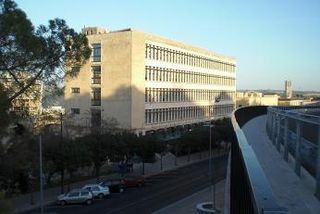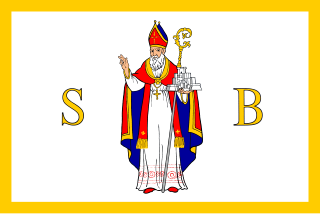Ragusa is the historical name of Dubrovnik. It may also refer to:
Dalmatian or Dalmatic is an extinct Romance language that was spoken in the Dalmatia region of present-day Croatia, and as far south as Kotor in Montenegro. The name refers to a tribe of the Illyrian linguistic group, Dalmatae. The Ragusan dialect of Dalmatian, the most studied prestige dialect, was the official language of the Republic of Ragusa for much of its medieval history until it was gradually supplanted by other local languages.

The Province of Ragusa was a province in the autonomous region of Sicily in southern Italy, located in the south-east of the island. Following the abolition of the Sicilian provinces, it was replaced in 2015 by the Free municipal consortium of Ragusa. Its capital is the city of Ragusa, which is the most southerly provincial capital in Italy.

The Republic of Ragusa was an aristocratic maritime republic centered on the city of Dubrovnik in Dalmatia that carried that name from 1358 until 1808. It reached its commercial peak in the 15th and the 16th centuries, before being conquered by Napoleon's French Empire and formally annexed by the Napoleonic Kingdom of Italy in 1808. It had a population of about 30,000 people, of whom 5,000 lived within the city walls. Its Latin motto was "Non bene pro toto libertas venditur auro", which means "Liberty is not well sold for all the gold".

Flora Zuzzeri was a lyric poet from the Republic of Ragusa. She wrote in Italian, Latin and Croatian.
Sebastiano Dolci was a Ragusan writer. In 1750 he published a biography of Saint Jerome. He joined the Franciscans at the age of 14 years, in 1744 he wrote about the Franciscan Order in Ragusa. The Italian word Dolci means Sweet (Confectionery) in English language. The word Slade is Croatian language variation of the word Dolci.

Natali was a noble family of the Republic of Ragusa. The family originated in Split and moved to Dubrovnik in 1667.
The Battle of Bileća was fought in August 1388 between the forces of the Kingdom of Bosnia led by Grand Duke of the kingdom, Vlatko Vuković, and the Ottoman Turks under the leadership of Lala Şahin Pasha. The Ottoman army broke into Zachlumia, the kingdom's southern region. After days of looting, the invaders clashed with the defending force near the town of Bileća, ending in the latter's decisive victory.
Kujava Radinović was the second wife of King Stephen Ostoja of Bosnia and as such she was Queen of Bosnia from 1399 to 1404 and again from 1409 to 1415. She was the daughter of the nobleman Radin Jablanić.

The Dubrovnik subdialect is a subdialect of the Shtokavian dialect of Serbo-Croatian. It is spoken in the area of Dubrovnik and the littoral of the former Republic of Ragusa, from Janjina on the Pelješac peninsula to the Croatian border with Montenegro.

The Cerva family, known in Croatian as Crijević, was a Ragusan noble family from Ragusa, which held noble titles in the Republic of Ragusa, and in the Austrian and Austro-Hungarian empires. Descendants of the family live in Austria and Italy.

The Tudisi waere a Ragusan noble family, which produced people such as distinguished diplomat Martholus de Tudisio and merchant Give de Tudisio in the 14th century. The basis of their economy was ties with the Republic of Venice in the 14th and 15th centuries. They were among the eleven smallest houses in the 15th century. After 1808, with the French occupation and division of the Ragusan nobility into two groups, the family joined the Salamancanists, along with the Bassegli, Benessa, Bonda, Buća, Giorgi-Bona, Gradi, Ragnina and Resti, while Gondola, Palmotta, Proculo were Sorbonnists; the rest of Ragusan nobility had branches, more or less, in both groups. The family moved to Venice, as did many of the other Ragusan patrician families.
The War of Hum was fought in 1326–1329 between the Banate of Bosnia under Stephen II Kotromanić and the Kingdom of Serbia under Stefan Dečanski Nemanjić.
Stephen Ostojić was King of Bosnia from the death of his father Ostoja in 1418 until his deposition by the nobility in 1420.

The Siege of Ragusa was fought between local Ragusan insurgents, as well as Austrian Croat troops and the British Royal Navy under Captain William Hoste against a French garrison under Joseph de Montrichard between 19 and 27 January 1814 during the Adriatic campaign of the Napoleonic Wars. The siege was fought on the coast of the Adriatic Sea for possession of the strategically important fortified town of Ragusa.

The Flag of Dubrovnik is the symbol of the city of Dubrovnik, originating as the flag of the historical Republic of Ragusa.

The Ragusan perpera was a type of silver coin issued and used in the Republic of Ragusa/Republic of Dubrovnik.
A war was fought between the Kingdom of Bosnia and the Republic of Ragusa in 1403. In 1403 Stephen Ostoja of Bosnia sided with King Ladislaus of Naples in his plights against the Hungarian King Sigismund, Bosnia's liege. King Ostoja led a war against the Ragusans, Sigismund's allies.
Anica Bošković was a Ragusan writer. She wrote a pastoral song and translated from the Italian language. Educated by Jesuits, Christian themes permeate her work. Hers was one of the first important women's names in Ragusan literature. The Dialogue (1758), was the first and sole literary work written by a female author in the literature of Ragusa.
Luka Paskalis Primojević was an early 16th-century Ragusan noble man and chancellor. He belonged to a noble Primojević family. His father Paskoje and brothers Trajan and Niko were also scribes. In March 1514 Luka requested from the Ragusan Senate an approval to establish a printing house in Dubrovnik and to print books in Latin, Greek and Cyrillic scripts. The Ragusan Senate gave its approval valid for one year. A year later he wrote a request to senate to prolong the validity of this approval for eight months.








